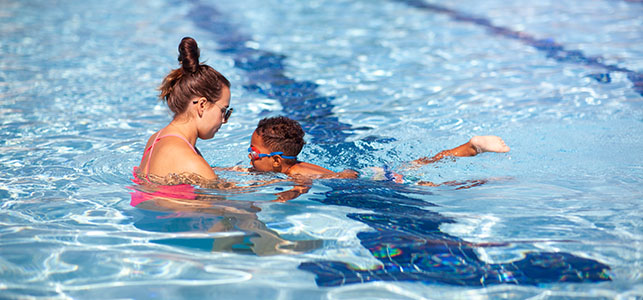
Drowning deaths are on the rise for the first time in decades. While this is cause for alarm, it doesn’t mean you need to cancel your plans for summer fun.
“Summertime presents many opportunities to be in and around water – from swimming in pools to boating on lakes and splashing in the ocean waves. These activities, while an awful lot of fun, can be quite dangerous without the proper precautions,” said Corri Miller-Hobbs, RN, program coordinator for Safe Kids Virginia at CHoR, part of our Level I pediatric trauma center. “Our safety team at CHoR urges families – and any adults caring for children – to brush up on water safety knowledge and skills. The latest data on drowning deaths underscores how important this is.”
Everyone should learn to swim when they’re able. This can begin with adult-child classes and transition to swim lessons when children are about 4 years old. The right time for your child will depend on their individual readiness and abilities.
Knowing the strokes isn’t enough, though. Kids should practice and master these five key water survival skills:
Even the strongest swimmers should never swim alone. Teach your children not to go in or near water without an adult present as the designated “water watcher.” For little ones, the American Academy of Pediatrics recommends “touch supervision,” which means staying within arm’s reach of the child when in or around water.
You’re actively watching kids in the water, but how do you know if they’re playing or truly in trouble? Jump into action immediately if you notice a swimmer:
What next? Once you see someone in trouble, it’s time to quickly consider how to help without putting yourself in danger.
The American Red Cross says, “reach or throw, don’t go”:
When it comes to spotting your child in the water, the color of their swimsuit can make a big difference.
“Light colored bathing suits can blend into the water and be overlooked,” Miller-Hobbs added. “Add surface agitation, such as ripples from boats, wind or other swimmers and it becomes especially difficult to see clearly. A bright color helps in quickly identifying children. In cases of drowning, minutes can make all the difference.”
Experiments by Alive Solutions, a company specializing in aquatic safety, showed that:
Some swimwear manufacturers are even making a shift to offer more options in these vivid colors with safety in mind.

It’s never too late to learn to swim, even if you’re an adult! This is especially important if you will be the designated water watcher when children are swimming. The American Red Cross, YMCA and other community organizations offer swim lessons for people of all ages.
Schools throughout the region also offer learn to swim programs at no cost to students.